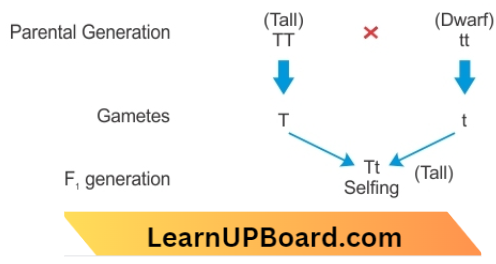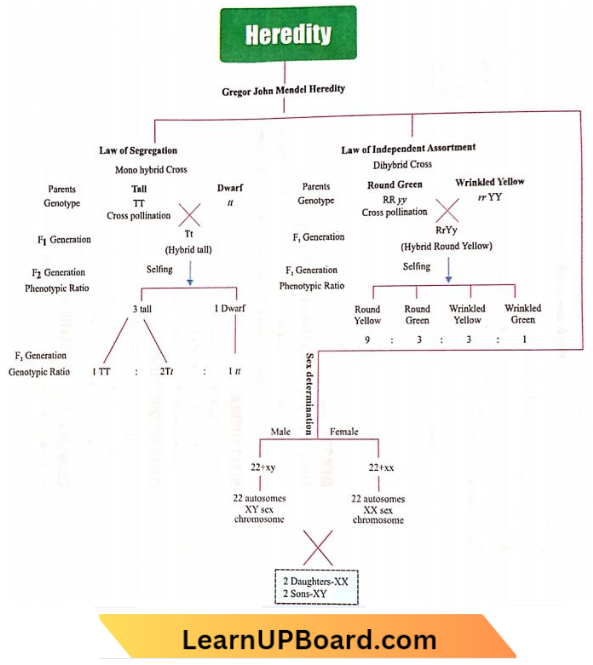Heredity Questions and Answers
Question 1.
- What is genetics?
- Give the common name of the plant on which Mendel performed his experiments.
- What for did Mendel use the term factors and what are these factors called now?
- What are genes? Where are the genes located?
Heredity and Evolution, Class 10 question answer
Answer:
- Genetics: It is the study of genes, genetic variations and laws governing the passage of heredity from generation to generation.
- Garden Pea, Edible Pea.
- Factors: They are particulate entities which function as units of inheritance that are transferred from generation to generation without being deleted or lost. The factors are now known as
- Genes: Genes are units of genetic material that have particular functions in inheritance. They are linear segments of DNA/chromosomes.
Question 2. How do Mendel’s experiments show that the
- Traits may be dominant or recessive.
- Traits are inherited independently.
Answer:
Traits are Dominant or Recessive: This can be discovered by performing a monohybrid cross. A between pure round-seeded and pure wrinkled-seeded plants yields only round-seeded plants in the F1 generation. Self-pollination of F1 plants yields both round-seeded and wrinkled-seeded plants in the ratio of 3:1. TIIIH to poHHiblo only If (lie allele lor wrinkled seed to present in F1 generation but is unable to express its effect, Therefore, the trail of wrinkled seed is recessive while the trait of round seed which is expressed in a generation is dominant.
class 10 heredity questions
Independent Inheritance of Traits: This can be found by performing a dihybrid cross. A cross between pure round and yellow seeded (RRYY) Pea plant with pure wrinkled and green seeded (rryy) plant yields rounded and yellow seeded F1 generation. Self-polIination of F1 plants gives rise to four types of plants—round yellow (9/16), round green (3/16), wrinkled yellow (3/16) and wrinkled green (1/16). Here round yellow and wrinkled green are parental types. Round green and wrinkled yellow are recombinations which can develop only if the factors for these traits are inherited independently of one another.
Question 3.
- How many pairs of chromosomes are present in human beings? Out of these how many arc sex chromosomes 7 How many types of sex chromosomes are found in human beings?
- “The sex of a newborn child is a matter of chance and none of the parents may be considered responsible for it”. Draw a flowchart showing the determination of the sex of the newborn to justify the statement.
Answer:
Human beings have 23 pairs of chromosomes. One pair of chromosomes are sex chromosomes or allosomes. In females both the sex chromosomes are similar. They are called XX chromosomes. In males, the two sex chromosomes are different (heteromorphic). One is a normal X chromosome (as found in females). The second is a shorter Y chromosome.
Question 4.
- What are dominant and recessive traits?
- “Is it possible that a trait is inherited but may not be expressed in the next generation ?’’ Give a suitable example to justify this statement.
Answer:
Dominant Trait: It is that trait which expresses its effect in both homozygous and heterozygous states, Example TT, Tt.
Recessive Trait: It is that trait which is unable to express its effect in the heterozygous state, i.e., in the presence of its alternate trait. The trait expresses its effect in only the homozygous state, Example tt.
Question 5. If we cross purebred tail (dominant) Pea plants with purebred dwarf (recessive Pea plants) we get Pea plants of F1 generation. If we now self-cross the Pea plants of the F1 generation, then we obtain Pen plants of the F2 generation
- What do the plants of the F1 generation look like?
- What is the ratio of tall plants to dwarf plants in F2 generation?
- State the types of plants not found in the F1 generation but appeared in the F2 generation, mentioning the reason for the same.
- What are homologous structures? Give an example. Is it necessary that homologous structures always have common ancestors?
Answer:
- F1 Generation. All tall p
- F2 Gcncmtlon: 3 tall; I dwarf.
- Dwarf plant: The trait of dwarfness is recessive and cannot express its effect in the presence of an alternate dominant trait.
- Homologous Structures, See question 5 above. Homologous structures always have common ancestors,
Question 6.
- What Is the law of dominance? Explain with an example.
- What is genetics?
- What are genes? Where are the genes located?
Answer:
Law of Dominance. Out of the two contrasting factors or alleles of a character if present together as in a hybrid, only one factor called dominant expresses its effect. The other factor called recessive docs not express its effect.
Example Cross a pure tall Rea plant with a pure dwarf Pea plant. All the individuals of the F1 generation are tall though they carry the factor of dwarfness as well.

Question 7.
- What does the F1 progeny of tall plants with round seeds and short plants with wrinkled seeds look like?
- What are recessive traits?
- Mention the type of new combination of plants obtained in F2 progeny along with their ratio, if F1 progeny was allowed to self-pollinate.
- If 1600 plants were obtained in F2 progeny, write the number of plants having traits
- Tall with round seeds
- Short with wrinkled seeds. Write the conclusion of the above experiment.
Answer:
- Round and tall (both the traits are dominant over wrinkled seed and short height).
- Recessive traits are those traits which are unable to express their effect in the presence of their alternate traits, as in the F1 generation.
- New Combinations
- Tall and wrinkled seeded = 3/16
- Short and round seeded = 3/16
- Tall with round seeds—1600 x 9/16 = 900
- Short with wrinkled seeds—1600 x 1/16 = 100.
Conclusion: The two factors of a character separate independently of the two factors of another character, coming together randomly at the time of fertilization. It is called the law of independent assortment.



